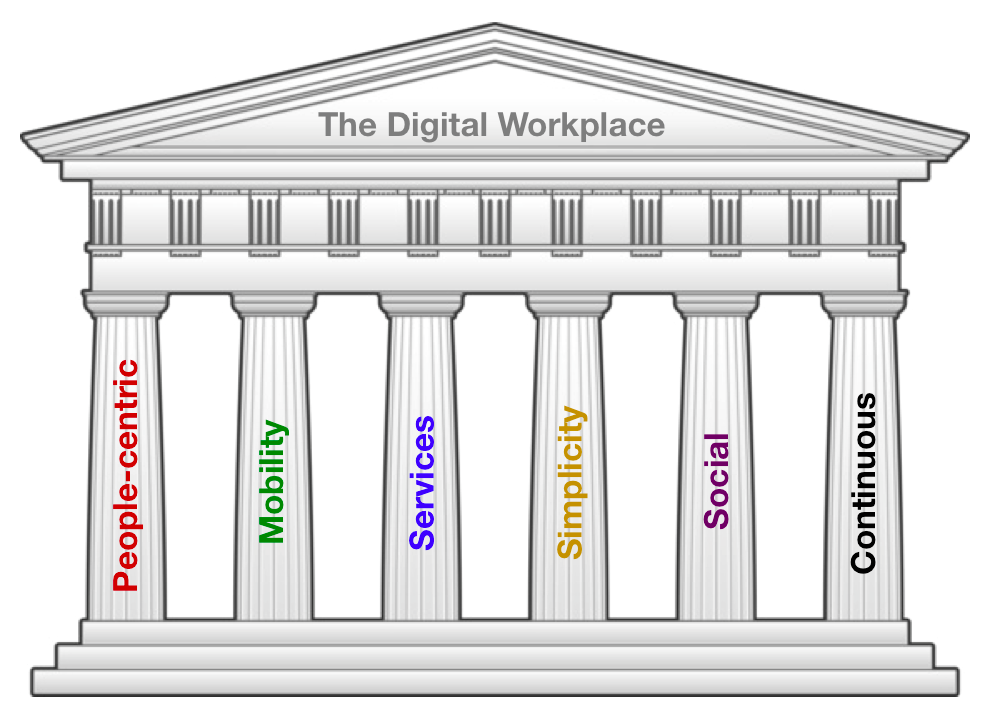
Digital Workplace
The Digital Workplace is the natural evolution of the company’s intranet: a specific corporate’s digital space where all key applications and processes (communication, collaboration, knowledge, business processes, etc.) are managed through new interactive ways and social networking practices among participants.
A Digital Workplace project is therefore complex and very challenging because it hasn’t only a technological aspect but also a cultural impact.
It is important to co-design and co-create the Digital Workplace with all stakeholders within the organization by systematically acting on the various aspects behind its success, such as:
- Governance: definition of roles, rules and processes needed to manage the initiative;
- Analysis and design: involvement and co-creation with users through surveys, workshops, focus groups and interviews;
- Technologies: identifying the right solutions to support needs and user experience;
- Change management: initiatives to support the cultural change.
A Digital Workplace project has a technological aspect but also a cultural impact
When thinking of creating a complete ecosystem for a digital workplace it often tends to focus attention on devices, services, and locations by forgetting the true purpose of the project, that is the experience of employees. Everyone focus about application, framework, smart working and connectivity but what matters to the person who will use it is the experience: The user experience (UX) can be a great starting point to help the employees to do their job efficiently without stress, and gain benefits such as employee involvement, revenue growth and increase of the productivity. Having a pleasant experience is a key motivation for using the system.
You can invest many resources in a digital work environment, but if nobody uses it, it’s a useless and expensive exercise
The 4 pillars of the digital workplace
The digital workplace must be social, flexible, simple, customizable and secure. All of this requires IT departments to start thinking outside the schemas following these four pillars:
- Segment technology by usage
The first step to creating a concrete roadmap to plan a digital workplace is to find out how employees are using technology right now and what tools they expect from use to perform their daily tasks. This may seem obvious, but sometimes there is a gap between what management says and what is happening in the field. IT has to elaborate a segmentation based on how technology is used, much more relevant than a traditional segmentation based on job title and management line. This bottom-up approach must be combined with a vision from the top of the company’s strategy for make sure everyone is aligned. Once the segments are defined, it is important to describe each character, the typical employee of a particular sector, and position it in one day’s dynamics. - CIOs need to have a better understanding
Creating employee travel through segmentation enables the IOC and senior management to better understand business needs and help the IT department to learn each other’s role. It is also a great opportunity for employees to provide feedback and advice on the expected evolution of the digital work environment. After setting a goal for each segment, a gap analysis allows you to expand the roadmap for the digital work environment, considering the organizational, legal, IT and financial. Finally, IT can see the value from starting to use. - To give people power
The important thing is to not forget that the crucial point of creating a digital work environment is to give more power to all employees. You can make a big investment in technology, but in the end people are the biggest resource. Change management needs to focus on business processes, but needs to put users and customers in the center. - Adapt physical work spaces
Workers are no longer tied to their computers and are forced to sit in a place for long periods of time so it is important to consider the impact of the digital work environment on the physical workstation. New trends are emerging, such as intelligent interaction with places: smart buildings and offices, along with smart assistants and robots. By creating a strategy for the digital work environment and implementing it now, companies can support the their global digital transformation, attracting new talents and creating the ground for new business opportunities.

How to start ???
So, start today with your digital workplace following these six steps:
- Create a comprehensive roadmap, based on your current capabilities, needs and market position;
- Identify and implement the platform, infrastructure and devices most suitable for your digital workplace;
- Simplify and automate business processes while at the same time integrating data and analytics;
- Design and implement digital services and experiences that will be available daily to your users;
- Promote adoption, innovation, social communities and collaboration to facilitate change;
- Create a digital culture that involves your employees and transform them into ambassadors of your organization.

